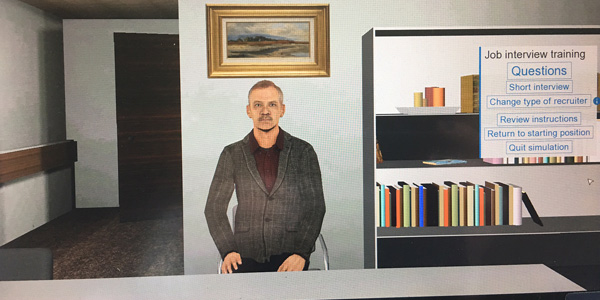What if you could isolate the independent variables in your research, keep costs down, and reach wider populations of research participants? What if your research situations were limited only by what you could dream up, regardless of practicality – how would that influence your research? With virtual reality, that’s all possible.
With virtual reality being used increasingly, we wanted to share how members are utilizing the technology, and how it’s impacting their research. Marianne Schmid Mast, professor of organizational behavior at the University of Lausanne, and Susan Persky, associate investigator in the Intramural Research Program at the National Human Genome Research Institute, National Institutes of Health discussed how virtual reality has influenced their work.
Workplaces
Marianne researches individuals’ verbal and nonverbal behaviors during social interactions in work settings. She uses immersive virtual reality to create simulations of these social interactions using virtual human social interaction partners. With immersive virtual reality, participants have a first-person perspective and can move around in the virtual world in the same ways as they do in the real world.
Marianne began using virtual reality as a part of her research to overcome the challenge that people’s interaction behavior is not completely independent of their social interaction partner’s behavior. It can be difficult to draw conclusions about participants if the social interaction partner does not interact in exactly the same way with every participant.
“If we observe differences among the participants, they can clearly be attributed to the participants because everything else, including the social interaction partner’s behavior, remains the same. Given the quality of the currently available virtual humans, the social interaction is experienced as very realistic,” Marianne said of using virtual humans.

“In almost 20 years of research using VR and virtual humans, none of our participants has ever tried to walk through a virtual human, something participants could do if they would not take the virtual human seriously,” Marianne said.
Virtual reality also makes it possible to alter aspects of the environment that would be challenging to change in real life (such as comparing whether leaders interact differently with subordinates during conversations in high-status or low-status offices). It would be hard to find two identical offices on the ground floor and top floor of a building, but creating that experience was possible using virtual reality.
An additional advantage of using virtual reality in social interaction research is straightforward logistics and relative inexpensiveness. If one wished to measure the persuasiveness of participants in giving a public speech to an audience, real people need to be scheduled and paid.
“Virtual humans are available 24/7, they do not have to be paid or scheduled, they never get tired, nor do they complain, and they pay equal attention to all participants and presentations, even at the end of the day,” Marianne said.
Marianne has begun using virtual reality for executive training. Managers can train public speaking with audiences, and the trainer can trigger a variety of audience reactions in response to the trainee. A virtual audience member can leave the room, or another virtual audience member can begin typing on her computer. If the participant is doing well, a virtual photographer can come to take a picture.
Health Spaces
Susan also uses virtual reality in her research. She studies communication, social attitudes, and health behavior in the context of genetics and genomics.
“The ultimate goal of my research program is to help pave the way for optimal communication about genetics and genomics with patients and communities, with an eye toward ensuring that medically underserved and stigmatized populations also benefit from these scientific advances,” Susan said.
Susan uses virtual reality in much of her research. She uses it to manipulate variables in a controlled way, such as using a virtual doctor to study the isolated influence of that doctor’s race on patients’ beliefs and attitudes after an interaction. Using virtual reality, participants are also immersed in a simulated doctor’s office setting, making the experience feel more realistic.

Virtual reality is also used in Susan’s research to collect behavioral measures. In the virtual doctor scenario, nonverbal communication behaviors exhibited by participants during the interaction were easily collected. These behaviors are easily collected because they are almost a byproduct of the sensors that control the virtual reality system.
Susan mentioned that the benefits of using virtual reality include the ability to isolate independent variables from natural confounds, which is very relevant to basic social psychology research. Additionally, its strengths for applied research include the ability to create any situation whether or not it is practically or physically possible, and increased mobility.
Like Marianne, Susan also focused on the straightforward logistics of using virtual reality.
“No matter what city or what conference room we happen to run our study out of, all of our participants will participate in the study from within the same virtual doctor’s office. This kind of mobility has allowed us to study populations that otherwise would have been unlikely to come to our lab for a study, like doctors, or patients with certain health conditions,” Susan said.
“We’ve published quite a bit on nonverbal and interpersonal behavior, and on fine-grained analysis of food choice behavior that, if collected in real life, would have required hours upon hours of set-up and coding by my team. Due to the resources required for collecting these outcomes in real life, this research likely would not have happened otherwise,” she said.
Thank you to Marianne and Susan for sharing information about their research, how they’re using virtual reality, and the benefits and impact of virtual reality on their work.




